Skype: neodalle-travel
Tel: +86 135 7447 2266
E-mail: sales@visitaroundchina.com

Wedding ceremony is on the selected day. Chinese people believe that wedding ceremoney is the most important thing in one's life, so they attach great importance. In Chinese weddings, people need to follow traditional customs.
(1) Wear wedding dress
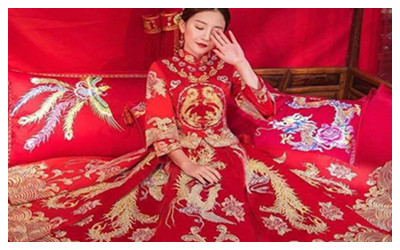 Unlike Western tradition, the color red dominates traditional Chinese weddings. Chinese people tend to use or wear red to add a joyful atmosphere of such a festive occasion.
Unlike Western tradition, the color red dominates traditional Chinese weddings. Chinese people tend to use or wear red to add a joyful atmosphere of such a festive occasion.
At dawn on the wedding day and after a bath in water permeated with grapefruit, the bride puts on new clothes, wears a pair of red shoes and waits for the so-called "good luck woman" to dress her hair in the style of a married woman. Her head would be covered with a red silk veil with tassels or bead strings that hang from the phoenix crown. She waits for her future husband to escort her home, with married women talking around her about how to be a good wife.
On the other hand, the bridegroom prepares himself to receive his wife. He gets capped and dressed in a long gown, red shoes and a red silk sash with a silk ball on his chest. The groom kneels at the ancestral altar as his father puts a cap decorated with cypress leaves on his head to declare his adulthood and his family responsibility.
(2) Receive bride
On that day, the bridegroom departs with a troop of escorts and musicians, playing cheerful music all the way to the bride's home.
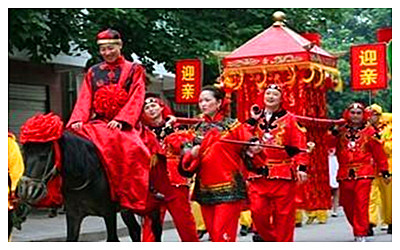 The bridegroom sets out to receive his bride. Usually a crowd of friends escorts the bridegroom and musicians play joyful tunes during the entire trip. Dancing lions, if any, precede the troop. in ancient times, a bridal sedan chair (or a decorated donkey due to poverty or bad traffic) would be used to transport the bride. A child carries a bridal box among the people, reflecting the bridegroom's expectation to have a child in the near future.
The bridegroom sets out to receive his bride. Usually a crowd of friends escorts the bridegroom and musicians play joyful tunes during the entire trip. Dancing lions, if any, precede the troop. in ancient times, a bridal sedan chair (or a decorated donkey due to poverty or bad traffic) would be used to transport the bride. A child carries a bridal box among the people, reflecting the bridegroom's expectation to have a child in the near future.
The most interesting part of the reception really takes place at the doorstep of the bride's residence, which is heavily guarded by the bridesmaid or the bride's sisters. It is customary for the bridesmaid to give the bridegroom a difficult time before he is allowed to enter. Usually wisdom, courage and his friends will help the bridegroom to succeed in his "trial". However, there is one more situation he has to negotiate with the bridesmaid and sisters of the bride - to distribute among them red packets containing money - in order to take his bride home.
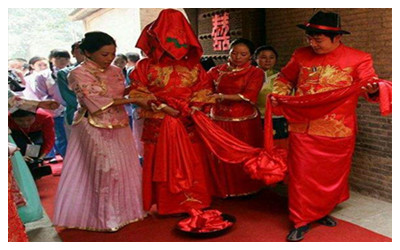 Before the bride departs to the bridegroom's home, the "good luck woman" will lead her to the sedan chair. On her way to the chair, one of her sisters will shield her with a red parasol, while another sister will throw rice at the sedan chair. At the back of the sedan hang a sieve and metallic mirror that are believed to protect the bride from evil. The bride has to cry to show that she does not want to leave her parents.
Before the bride departs to the bridegroom's home, the "good luck woman" will lead her to the sedan chair. On her way to the chair, one of her sisters will shield her with a red parasol, while another sister will throw rice at the sedan chair. At the back of the sedan hang a sieve and metallic mirror that are believed to protect the bride from evil. The bride has to cry to show that she does not want to leave her parents.
Then firecrackers will be set off to drive away evil spirits as the bride sits into the sedan chair. All along the way people make great efforts to avoid any inauspicious influence. For instance, the sedan chair is heavily curtained to prevent the bride from seeing an unlucky sight (e.g. a widow, a well or even a cat).
Carring the bride's dowry, the bride is escorted to the bridegroom's home. Usually the bride's dowry shall be sent to the bridegroom's family by the day before the wedding day. Sometimes the dowry will be brought by the bride's escorts. A traditional dowry normally consists of valuable items such as jewelry, embroidered beddings, kitchen utensils and furniture. The type of the dowry is constantly changing except for the basic, symbolic items. For example, dozens of years ago, a sewing machine, a bicycle, and a recorder were musts in a marriage. Now, they are totally out of fashion.
(3) Wedding Ceremoney
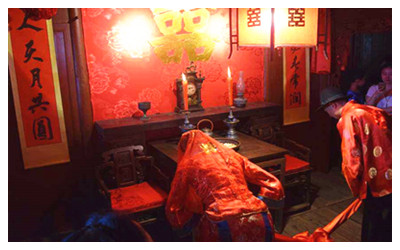 After getting to the bridegroom's home, the wedding ceremony begins. The wedding ceremony is the focus of interest. The bride and bridegroom are led to the family altar, where the couple kowtows to Heaven and Earth, the family ancestors and parents successively. They then bow to each other and are led to the bridal chamber. The ceremony proceeds under a director's prompts and applauses of the audience.
After getting to the bridegroom's home, the wedding ceremony begins. The wedding ceremony is the focus of interest. The bride and bridegroom are led to the family altar, where the couple kowtows to Heaven and Earth, the family ancestors and parents successively. They then bow to each other and are led to the bridal chamber. The ceremony proceeds under a director's prompts and applauses of the audience.
Afterwards, a grand feast is held for relatives and those who helped with the wedding. The newly wed couple will resume drinking wedding wine. Generally they are required to cross their arms to sip wine. They also will toast their guests. Guests voice their good wishes for the couple even though the bridegroom is trying to be humble while acting embarrassed.
Teasing games in the bridal chamber: After night falls, the teasing games start. Usually all young men can participate except for the bride's married brothers-in-laws. These funny and silly games help ease the tension, since in ancient times the newlyweds never met each other before the wedding! Most of the games require the shy couple to act like wife and husband. The festive atmosphere also promotes closeness among all the family members and the community beyond. There also will be other activities conducted by the bridegroom's mother after the roaring laughter fades into the darkness.
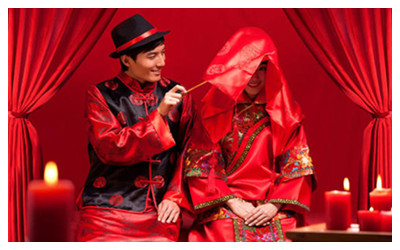 Preparing the bridal bed: A "good luck man", usually having a nice family, will help to install the bridal bed in the correct place in the bridal chamber on a selected day before the wedding day. Before the wedding, a "good luck woman" will arrange the bridal bed and scatter symbolic and lucky fruits on the bed. Nobody is allowed to touch the bed until the couple enters the bridal chamber after the wedding ceremony. Children will then be invited onto the bed to bless the couple with fertility.
Preparing the bridal bed: A "good luck man", usually having a nice family, will help to install the bridal bed in the correct place in the bridal chamber on a selected day before the wedding day. Before the wedding, a "good luck woman" will arrange the bridal bed and scatter symbolic and lucky fruits on the bed. Nobody is allowed to touch the bed until the couple enters the bridal chamber after the wedding ceremony. Children will then be invited onto the bed to bless the couple with fertility.
In China, traditional wedding customs lost their popularity due to the collapse of feudal marriage customs and their complexity. However, traditional marriage can still be seen in the countryside, despite innovations. Nowadays, traditional marriage customs are being revived in some places and they are attracting many prospective couples.
 Ask Questions ?
Ask Questions ?